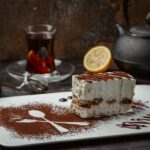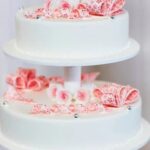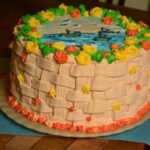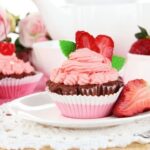Decorating a cake is like putting the icing on the cake, both literally and figuratively. Cake decorations play a crucial role in transforming a plain dessert into a visually stunning masterpiece. Whether it’s a simple birthday cake or an elaborate wedding cake, decorations bring life to the creation, adding flair and personalization.
The art of decorating cakes allows for endless creative possibilities. It’s an opportunity to showcase your personality and style, making each cake truly unique. From delicate buttercream flowers that look almost too pretty to eat, to intricate fondant designs that can resemble anything from a princess castle to an adorable creature, decorations elevate the aesthetic appeal of any cake.
With limitless techniques and tools at your disposal, you have the power to create edible works of art that will impress friends and family alike. The beauty of cake decoration lies in its ability to captivate with visual charm while still tantalizing taste buds. By investing time and effort into mastering the skill of decorating cakes, you can express your creativity through delicious confections that leave a lasting impression.
So, let your imagination run wild as we delve into the world of cake decorations. From exploring various types of decorations to learning essential techniques and tricks, this article will guide you on your journey towards becoming a master decorator. Get ready to unleash your creativity and make your cakes stand out with breathtakingly beautiful designs. Let’s dive right in.
Types of Decorations
Decorating a cake is an opportunity to showcase creativity and add a personal touch. There are various techniques for cake decoration, each offering its own unique style and effect. In this section, we will explore the different types of decorations and provide tips and tricks for creating stunning designs.
One popular technique for cake decoration is buttercream icing flowers. With just a few simple steps, you can create beautiful floral designs that will impress your guests. Start by piping a small dot in the center of the flower using a round tip. Next, pipe petals around the dot in a circular motion, gradually working your way outward. Finish off with carefully piped leaves to complete the look.
Another versatile option for cake decoration is fondant. This pliable icing allows you to create intricate designs and three-dimensional shapes with ease. To make fondant decorations, start by kneading the fondant until it becomes soft and pliable. Then, roll it out to your desired thickness and use cookie cutters or molds to create shapes or figures. To attach fondant decorations to your cake, simply brush the back of each piece with water or edible glue.
If you’re looking to add elegance to your cake, consider using chocolate ganache drizzles. This smooth and velvety icing can be poured over a cake or dripped from the top edge for a stunning effect. To create chocolate ganache drizzles, heat heavy cream until hot but not boiling, then pour it over chopped chocolate pieces.
Let it sit for a few minutes before stirring until smooth. Allow the ganache to cool slightly before pouring or drizzling it onto your cake.
In today’s digital age, you can also incorporate edible prints and images into your cake decorations for a personalized touch. Using technology such as edible ink printers or food coloring markers, you can print images or messages onto sheets made from sugar or rice paper that are safe for consumption. Simply apply these prints to your cake and watch as your design comes to life.
| Decoration Technique | Description |
|---|---|
| Buttercream Icing Flowers | Create floral designs using piped buttercream icing. |
| Fondant Decorations | Knead and shape fondant to create intricate designs or figures. |
| Chocolate Ganache Drizzles | Pour or drizzle smooth ganache over your cake for an elegant finish. |
| Edible Prints and Images | Add personalized designs or messages using edible ink printers or food coloring markers. |
With these various techniques at your disposal, you can experiment and mix and match to create stunning decorations that will make your cakes truly stand out. The next section will discuss the essential tools and ingredients you’ll need to bring these decoration techniques to life.
Essential Tools and Ingredients for Cake Decorations
To create beautiful cake decorations, it is essential to have the right tools and ingredients on hand. Whether you are a beginner or an experienced baker, having these key items in your kitchen will make the decorating process much easier and more enjoyable. Below is a showcase of must-have tools and an overview of specific ingredients required for different types of cake decorations.
Tools
- Piping bags: These are essential for piping icing onto cakes and creating various designs. Look for disposable bags for easy cleanup.
- Tips: Investing in a variety of piping tips will give you the flexibility to create different shapes and patterns. Popular tips include round tips for dots and writing, star tips for rosettes and borders, and petal tips for flower petals.
- Fondant cutters: If you want to try your hand at fondant decorations, having a set of fondant cutters will make shaping and cutting fondant a breeze.
- Offset spatula: This tool is perfect for spreading icing smoothly onto cakes and creating even layers.
- Turntable: A turntable makes it easier to rotate your cake while decorating, giving you full access to all sides without straining your wrist.
Ingredients
- Buttercream icing: Buttercream is one of the most common types of icing used in cake decoration. It can be easily colored with gel or liquid food coloring to match your desired palette.
- Fondant: Fondant is a pliable sugar dough that can be rolled out and used to cover cakes or create decorative elements like flowers and figurines. It comes in various colors but can also be dyed using gel food coloring.
- Food coloring: Whether using gel or liquid food coloring, having a selection of colors on hand will allow you to bring your creative ideas to life.
- Edible glue: This specialized adhesive is used when working with fondant or gum paste decorations. It helps attach various elements together securely.
- Edible glitter: Add a touch of sparkle to your cake decorations with edible glitter. It comes in different colors and can be applied using a brush or by sprinkling it over the desired area.
When it comes to finding these tools and ingredients, you can visit your local baking supply store or search online. Many online retailers offer a wide range of options and convenient delivery services.
Additionally, there are plenty of recipes and tutorials available on various websites and social media platforms that can guide you through the process. With the right tools and ingredients at your disposal, you’ll be well-equipped to create stunning cake decorations that will impress everyone who sees them.
Buttercream Piping Techniques
Mastering Simple Piping Techniques
One of the most versatile and commonly used cake decorating techniques is buttercream piping. This technique involves using a piping bag fitted with different tips to create various designs and patterns on the surface of the cake. For beginners, it is best to start with simple piping techniques such as dots, stars, and rosettes.
To create dots, simply attach a round tip to your piping bag and apply gentle pressure while squeezing out small dots onto the cake surface. You can create patterns by placing the dots close together or in a specific arrangement. Stars can be created using a star-shaped tip by applying consistent pressure while moving in a circular motion. Rosettes are made by forming a small spiral shape with consistent pressure using a star-shaped tip.
Progressing to More Complex Designs
Once you have mastered the basic piping techniques, you can move on to more complex designs that will add sophistication and elegance to your cakes. Ruffles, scrollwork, and basketweave are popular advanced techniques that will take your cake decorations to the next level.
To create ruffles, use a petal or leaf-shaped tip and apply steady pressure while moving from side to side in an upward motion. This creates beautiful frilled edges resembling fabric ruffles. Scrollwork involves creating intricate swirling patterns on the cake’s surface using decorative tips such as #1 or #2 round tips. Basketweave is achieved by alternating horizontal and vertical lines with gentle pressure using a basketweave tip.
Expert Tips for Achieving Professional-Looking Results
Achieving professional-looking results requires practice and attention to detail. Here are some expert tips that will help you elevate your buttercream piping skills:
- Consistency is key: Ensure that your buttercream icing is at the right consistency – not too stiff or runny – for achieving clean lines and smooth surfaces.
- Practice pressure control: Learn to control the amount of pressure you apply on the piping bag so that your lines and patterns are consistent in thickness and density.
- Pre-plan your design: Sketch out your design on paper before starting to pipe, especially for more complex designs, to ensure accuracy and precision.
- Use proper hand positioning: Hold the piping bag with one hand at the top for stability, while using the other hand to guide and control the movement of the piping tip.
- Have patience: Don’t rush. Take your time to execute each piped element properly, as rushing can lead to inconsistency and mistakes.
By incorporating these techniques and tips into your buttercream piping repertoire, you will be well on your way to creating beautifully decorated cakes that will impress friends and family alike. Remember that practice is key in developing your skills, so don’t be afraid to experiment and push yourself creatively.
Fondant Sculpting
Creating intricate 3D cake decorations using fondant is a popular technique that can take your cake to the next level. Fondant provides a smooth, pliable canvas that allows you to shape and mold various figures, flowers, and shapes with precision. In this section, we will provide a step-by-step guide on how to sculpt stunning fondant decorations for your cakes.
First, it’s important to gather all the necessary tools and materials before starting your fondant sculpting project. Some essential tools include a rolling pin, fondant smoother, modeling tools, and cornstarch or powdered sugar for dusting. It’s also helpful to have a set of different-shaped cutters or molds depending on the designs you want to create.
To begin sculpting with fondant, start by kneading the fondant until it becomes soft and pliable. Then, roll out the fondant evenly using a rolling pin on a surface dusted with cornstarch or powdered sugar. Use your chosen cutters or molds to create the desired shapes.
Once you have your basic shapes ready, it’s time to add dimension and detail. Use modeling tools to create texture and definition by making indents or marks on the surface of the fondant. You can also layer different pieces together for more complex designs.
As you work on your 3D fondant decorations, keep in mind that patience is key. Sculpting with fondant requires precision and attention to detail. Don’t be afraid to experiment and try different techniques until you achieve the desired look.
| Tools | Description |
|---|---|
| Rolling Pin | Used to evenly roll out fondant |
| Modeling Tools | Helps create texture and definition on the fondant |
| Fondant Smoother | Used to smooth out surfaces of fondant shapes |
| Cutters or Molds | Creates desired shapes for the decorations |
With these tips and techniques, you can now confidently sculpt stunning fondant decorations for your cakes. Whether it’s intricate flowers, realistic figurines, or intricate designs, fondant sculpting allows you to unleash your creativity and create show-stopping cakes. Remember to practice and experiment with different designs to truly make your cake stand out.
Decorating with Colors
Cake decoration is not just about shaping and sculpting edible materials; it also involves choosing the right colors to bring your design to life. The colors you choose can significantly impact the overall theme and tone of your cake. In this section, we will explore the significance of color psychology in cake decoration, different color schemes you can use, and techniques for applying color to icing and fondant accents.
The Significance of Color Psychology
Color psychology plays a crucial role in how people perceive and interpret visual stimuli. When it comes to cake decoration, understanding the emotional associations with different colors can help you create designs that convey the desired feelings or messages. Here are some common associations with certain colors:
- Red: symbolizes love, passion, and excitement
- Yellow: represents happiness, joy, and energy
- Blue: evokes feelings of calmness, serenity, and trust
- Green: associated with nature, growth, and balance
- Pink: often connected with femininity, sweetness, and romance
- Purple: signifies luxury, creativity, and spirituality
Understanding these associations can guide you in choosing colors that align with the occasion or theme of your cake.
Exploring Different Color Schemes
When putting together a color palette for your cake decorations, it’s essential to consider different color schemes that harmonize well together. Here are a few popular color schemes you can experiment with:
- Monochromatic: using various shades and tints of a single color for a cohesive look.
- Analogous: combining colors that are adjacent on the color wheel for a harmonious effect.
- Complementary: pairing colors opposite each other on the color wheel to create contrast and visual interest.
- Triadic: selecting three colors evenly spaced around the color wheel for a vibrant and balanced design.
By understanding these color schemes, you can create visually appealing cake decorations that stand out.
Techniques for Applying Color
Once you have chosen your color palette, it’s time to apply it to your cake decorations. There are various techniques you can use to add color to icing and fondant accents:
- Airbrushing: using an airbrush tool to spray a fine mist of color onto the surface of the cake or decorations.
- Painting: using edible paints and brushes to hand-paint intricate designs on fondant or gum paste figures.
- Dusting: using luster dust or petal dust to add shimmer or matte finishes to decorations.
- Piping: incorporating colored icing into piping bags with different tips for creating intricate designs directly on the cake.
Experimenting with these techniques will allow you to achieve the desired effect and bring your cake decorations to life in vibrant colors.
Remember, choosing the right colors and applying them skillfully can make your cake decorations truly stand out. So, unleash your creativity and explore different color palettes and application techniques to create beautifully decorated cakes that leave a lasting impression.
Finishing Touches
Adding those final touches to your cake decorations can elevate them from ordinary to extraordinary. These finishing touches are what truly make your cake stand out and impress your guests. In this section, we will explore some techniques and ideas to add that extra flair to your decorations.
Utilizing Edible Paints and Luster Dust
One way to enhance your cake decorations is by using edible paints and luster dust. Edible paints can be used to add vibrant colors or intricate details to your fondant decorations. It allows you to create depth and dimension, bringing your decorations to life.
Luster dust, on the other hand, adds a metallic or shimmer effect that can make your cake look luxurious and elegant. It comes in a variety of colors, so you can choose one that complements your overall design.
Enhancing with Edible Glitter, Sprinkles, and Pearls
Another way to add flair is by incorporating edible glitter, sprinkles, and pearls into your decorations. Edible glitter can give your cake a touch of sparkle and glamour. You can sprinkle it over buttercream flowers or use it as accents on fondant designs.
Sprinkles come in various shapes, sizes, and colors, allowing you to customize your cake according to the theme or occasion. Pearls are delicate little sugar beads that can be placed strategically around your cake for an elegant touch.
Incorporating Fresh Flowers, Edible Lace, and Unique Elements
For a more natural and organic touch, consider incorporating fresh flowers into your cake decorations. Select flowers that are safe for consumption and ensure they are securely positioned on the cake using food-safe methods such as flower spikes or toothpicks. This not only adds beauty but also a delightful aroma to the cake.
Another unique element you can include is edible lace made from either lace molds or royal icing techniques. Edible lace can create a stunning and intricate design on your cake. You can also experiment with other unique elements like wafer paper, edible gold leaf, or even real gold flakes.
By adding these finishing touches, you can take your cake decorations to the next level. Experiment with different techniques and ideas to unleash your creativity and make your cake truly memorable. Remember to have fun throughout the process and don’t be afraid to think outside the box when it comes to adding that extra flair to your decorations.
Storage and Preservation
After putting in the time and effort to create beautiful cake decorations, it’s important to know how to properly store and preserve them. By taking proper care of your decorations, you can ensure that they maintain their beauty and freshness for as long as possible. Here are some tips on how to store and preserve your cake decorations.
One important tip is to keep your decorations in a cool, dry place. Moisture can cause decorations made with fondant or edible paper to become soft or even dissolve. It’s best to store them in an airtight container or packaging to protect them from humidity.
For delicate sugar flowers or other fragile decorations, it’s advisable to wrap them individually in tissue paper or plastic wrap before placing them in a storage container. This will help prevent any breakage or damage during storage.
Another consideration is the lifespan of certain decorations. Edible prints and images made with frosting sheets will generally last for several months if stored properly, while chocolate ganache drizzles may harden within a few days. It’s important to take note of expiration dates for any store-bought toppings or edible elements.
If you find yourself with leftover cake decorations after completing a project, don’t let them go to waste. Get creative and repurpose them for future desserts. Edible glitter, sprinkles, or pearls can be used on cupcakes or cookies, while fondant shapes or figures can be saved for future cakes.
By following these storage and preservation tips, you can prolong the life of your cake decorations and maintain their original beauty. Remember that practice makes perfect when it comes to both creating and preserving these artistic touches on your cakes.
Conclusion
In conclusion, decorating cakes is not only a way to make them visually appealing, but it also allows for creativity and personalization. By utilizing various techniques such as buttercream icing, fondant sculpting, and chocolate ganache drizzles, you can transform a simple cake into a work of art. With the right tools and ingredients, anyone can enhance their cake with intricate designs and vibrant colors.
Throughout this article, we have explored the fundamentals of cake decoration. From mastering basic piping techniques to creating 3D fondant sculptures, we have provided step-by-step guides and expert tips to help you achieve professional-looking results. We have also discussed the importance of selecting the right color palette for your cake design and adding finishing touches such as edible paints, glitter, and pearls.
The key takeaway from this article is to embrace your creativity and let it shine through your cake decorations. Don’t be afraid to experiment with different techniques and ideas. Remember that practice makes perfect in the art of cake decoration.
By incorporating unique elements and finding ways to make your decorations stand out, you can create cakes that are not only delicious but also visually stunning. So go ahead, unleash your imagination, and make your cakes a true reflection of your artistic flair.

Welcome to my blog about home and family. This blog is a place where I will share my thoughts, ideas, and experiences related to these important topics. I am a stay-at-home mom with two young children. I hope you enjoy reading it! and may find some helpful tips and ideas that will make your home and family life even better!





